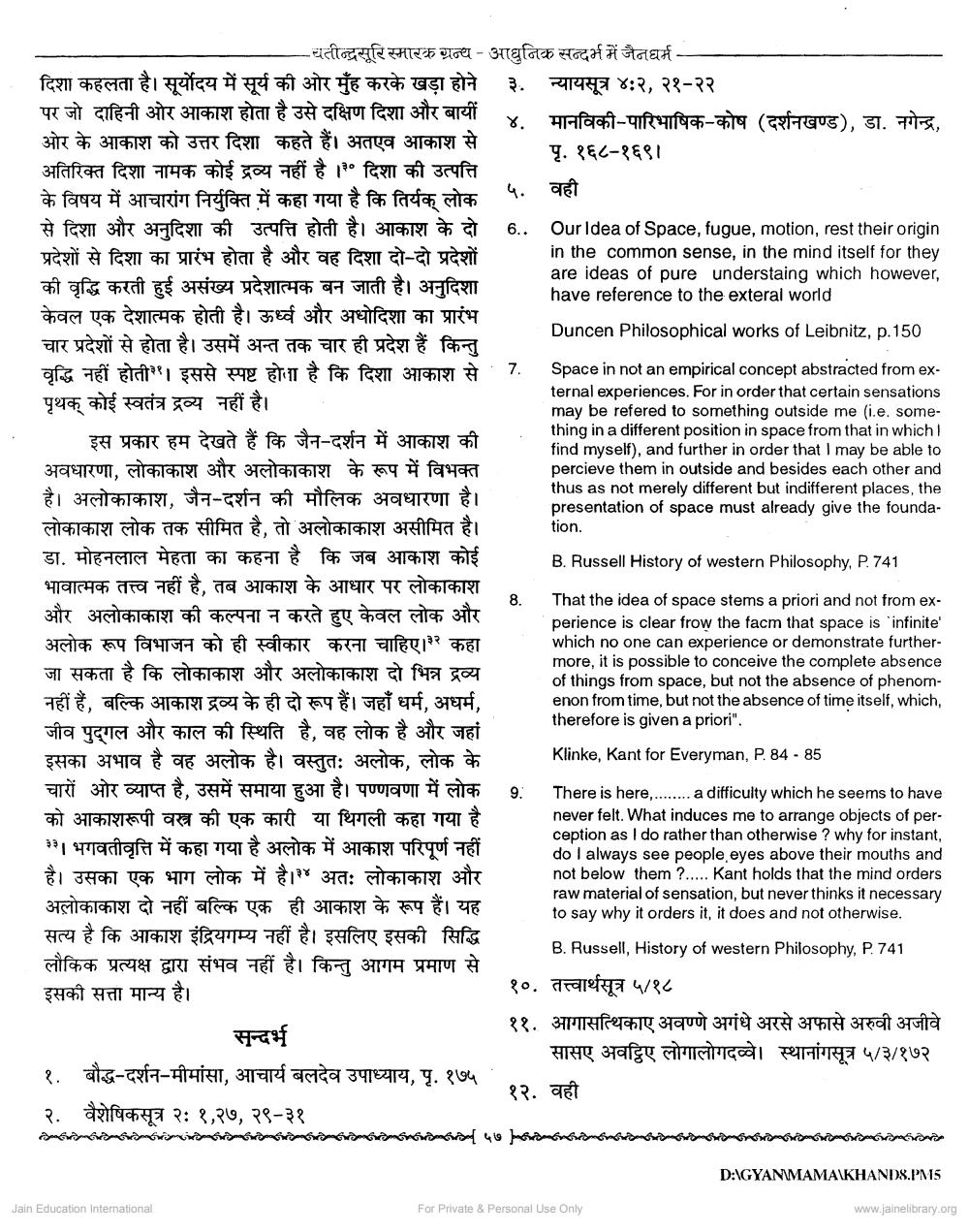________________
४.
-चतीन्द्रसूरि स्मारक ग्रन्थ - आधुनिक सन्दर्भ में जैनधर्म - दिशा कहलता है। सूर्योदय में सूर्य की ओर मुँह करके खड़ा होने ३. न्यायसूत्र ४:२, २१-२२ पर जो दाहिनी ओर आकाश होता है उसे दक्षिण दिशा और बायीं ।
मानविकी-पारिभाषिक-कोष (दर्शनखण्ड), डा. नगेन्द्र, ओर के आकाश को उत्तर दिशा कहते हैं। अतएव आकाश से
पृ. १६८-१६९। अतिरिक्त दिशा नामक कोई द्रव्य नहीं है ।३० दिशा की उत्पत्ति के विषय में आचारांग नियुक्ति में कहा गया है कि तिर्यक् लोक ५.
५. वही से दिशा और अनुदिशा की उत्पत्ति होती है। आकाश के दो 6.. Our Idea of Space, fugue, motion, rest their origin प्रदेशों से दिशा का प्रारंभ होता है और वह दिशा दो-दो प्रदेशों in the common sense, in the mind itself for they
are ideas of pure understaing which however, की वृद्धि करती हुई असंख्य प्रदेशात्मक बन जाती है। अनुदिशा
have reference to the exteral world केवल एक देशात्मक होती है। ऊर्ध्व और अधोदिशा का प्रारंभ
Duncen Philosophical works of Leibnitz, p.150 चार प्रदेशों से होता है। उसमें अन्त तक चार ही प्रदेश हैं किन्तु वृद्धि नहीं होती। इससे स्पष्ट होता है कि दिशा आकाश से 7. Space in not an empirical concept abstracted from ex
ternal experiences. For in order that certain sensations पृथक् कोई स्वतंत्र द्रव्य नहीं है।
may be refered to something outside me (i.e. someइस प्रकार हम देखते हैं कि जैन-दर्शन में आकाश की
thing in a different position in space from that in which
find myself), and further in order that I may be able to अवधारणा, लोकाकाश और अलोकाकाश के रूप में विभक्त percieve them in outside and besides each other and है। अलोकाकाश, जैन-दर्शन की मौलिक अवधारणा है।
thus as not merely different but indifferent places, the
presentation of space must already give the foundaलोकाकाश लोक तक सीमित है, तो अलोकाकाश असीमित है। tion. डा. मोहनलाल मेहता का कहना है कि जब आकाश कोई
B. Russell History of western Philosophy, P. 741 भावात्मक तत्त्व नहीं है, तब आकाश के आधार पर लोकाकाश
That the idea of space stems a priori and not from exऔर अलोकाकाश की कल्पना न करते हुए केवल लोक और
perience is clear frow the facm that space is 'infinite अलोक रूप विभाजन को ही स्वीकार करना चाहिए।३२ कहा which no one can experience or demonstrate further
more, it is possible to conceive the complete absence जा सकता है कि लोकाकाश और अलोकाकाश दो भिन्न द्रव्य
of things from space, but not the absence of phenomनहीं हैं, बल्कि आकाश द्रव्य के ही दो रूप हैं। जहाँ धर्म, अधर्म, enon from time, but not the absence of time itself, which,
therefore is given a priori". जीव पुद्गल और काल की स्थिति है, वह लोक है और जहां इसका अभाव है वह अलोक है। वस्तुतः अलोक, लोक के
Klinke, Kant for Everyman, P. 84 - 85 चारों ओर व्याप्त है, उसमें समाया हुआ है। पण्णवणा में लोक 9.
There is here......... a difficulty which he seems to have को आकाशरूपी वस्त्र की एक कारी या थिगली कहा गया है never felt. What induces me to arrange objects of per
ception as I do rather than otherwise ? why for instant, ३३ | भगवतीवृत्ति में कहा गया है अलोक में आकाश परिपूर्ण नहीं
do I always see people eyes above their mouths and है। उसका एक भाग लोक में है।३४ अतः लोकाकाश और not below them ?..... Kant holds that the mind orders
raw material of sensation, but never thinks it necessary अलोकाकाश दो नहीं बल्कि एक ही आकाश के रूप हैं। यह
to say why it orders it, it does and not otherwise. सत्य है कि आकाश इंद्रियगम्य नहीं है। इसलिए इसकी सिद्धि
B. Russell, History of western Philosophy, P.741 लौकिक प्रत्यक्ष द्वारा संभव नहीं है। किन्तु आगम प्रमाण से इसकी सत्ता मान्य है।
१०. तत्त्वार्थसूत्र ५/१८ सन्दर्भ
११. आगासत्थिकाए अवण्णे अगंधे अरसे अफासे अरुवी अजीवे
सासए अवट्रिए लोगालोगदव्वे। स्थानांगसूत्र ५/३/१७२ १. बौद्ध-दर्शन-मीमांसा, आचार्य बलदेव उपाध्याय, पृ. १७५ .
१२. वही २. वैशेषिकसूत्र २: १,२७, २९-३१ ansardarsanskarodaidodioraniramidnidian ५७ Hamritaminoransarsonsidaritaminodridaosaridrda
DIGYANMAMAIKHANIDS.PMS
Jain Education International
For Private & Personal Use Only
www.jainelibrary.org




